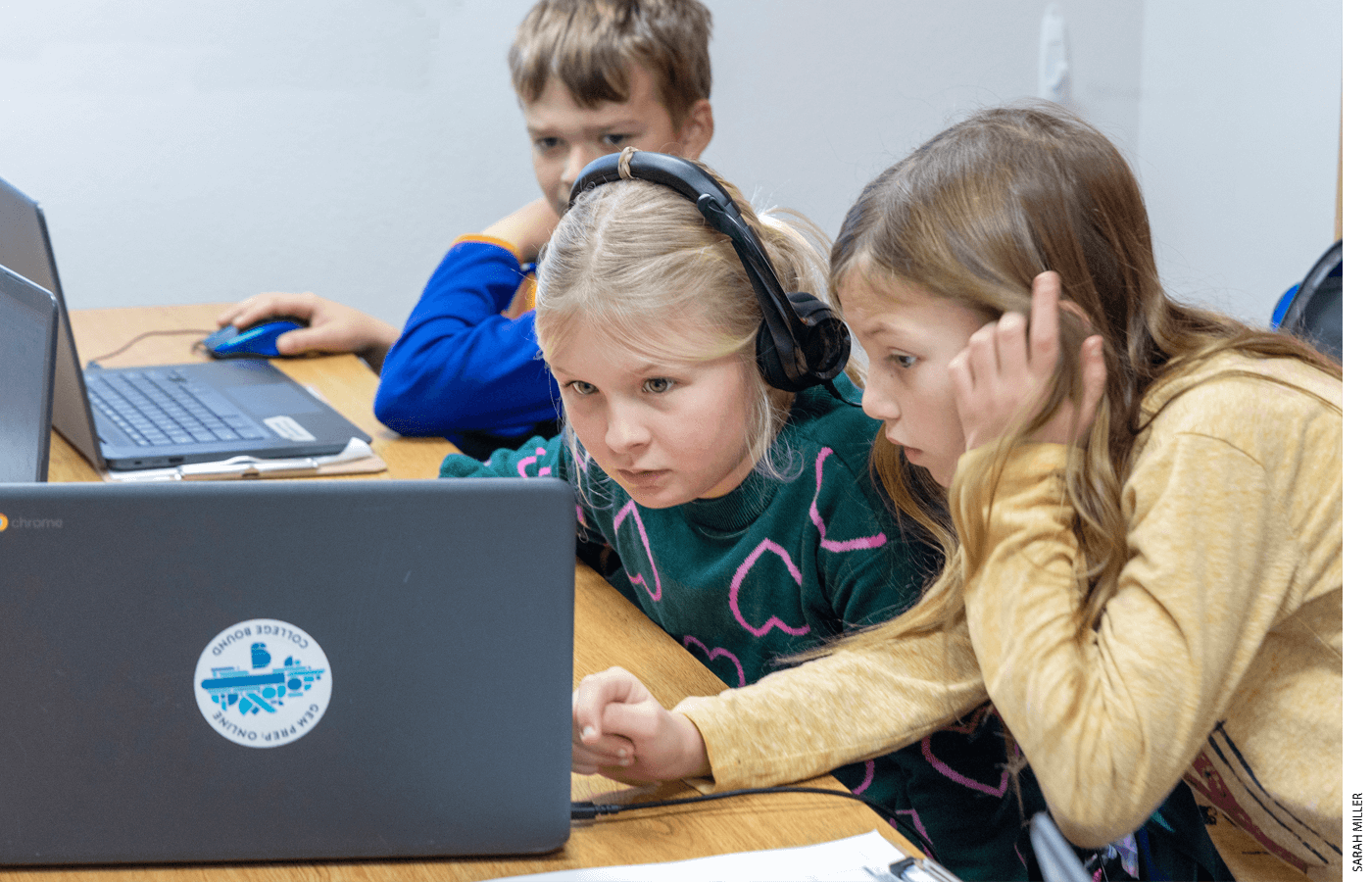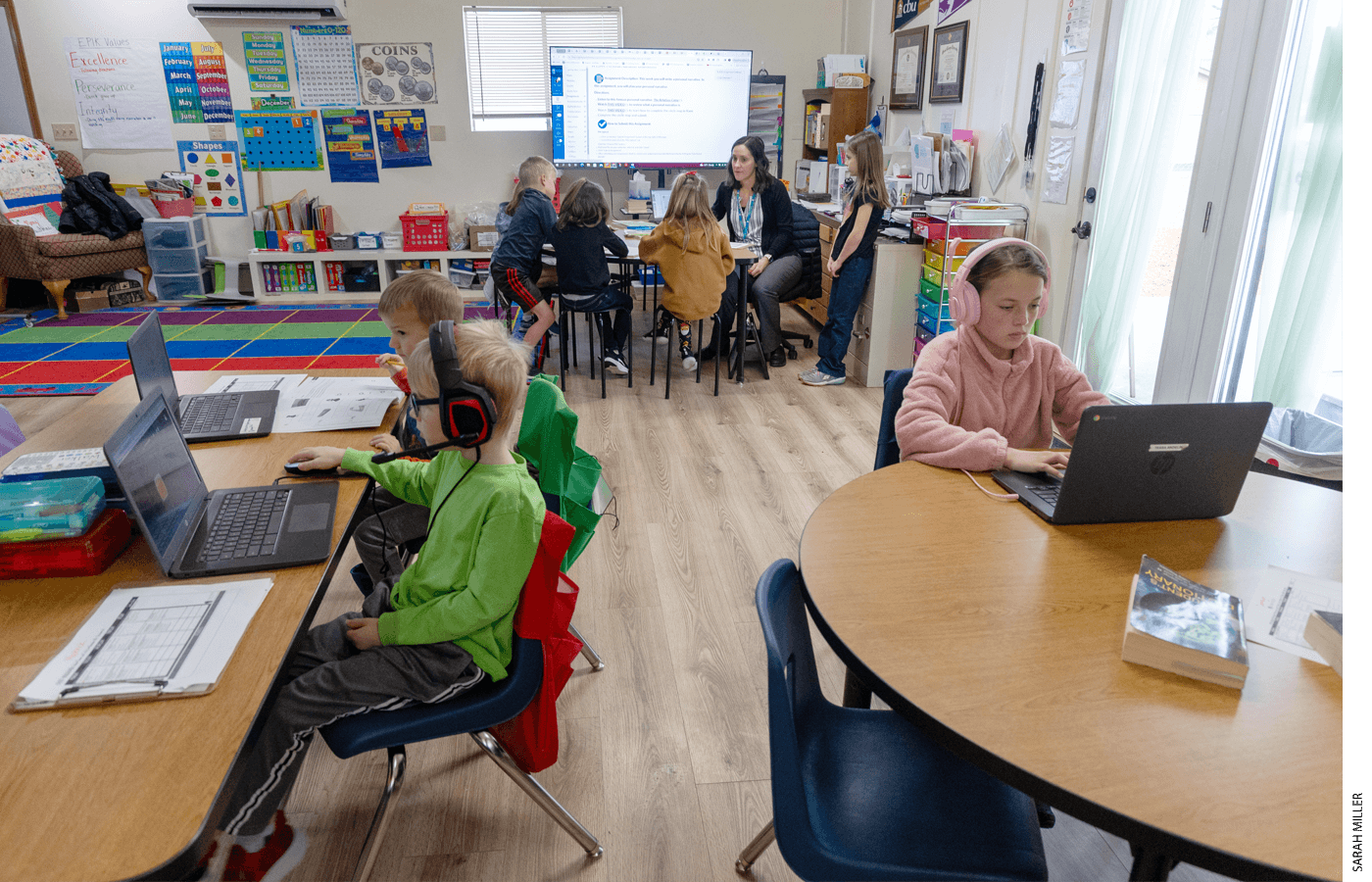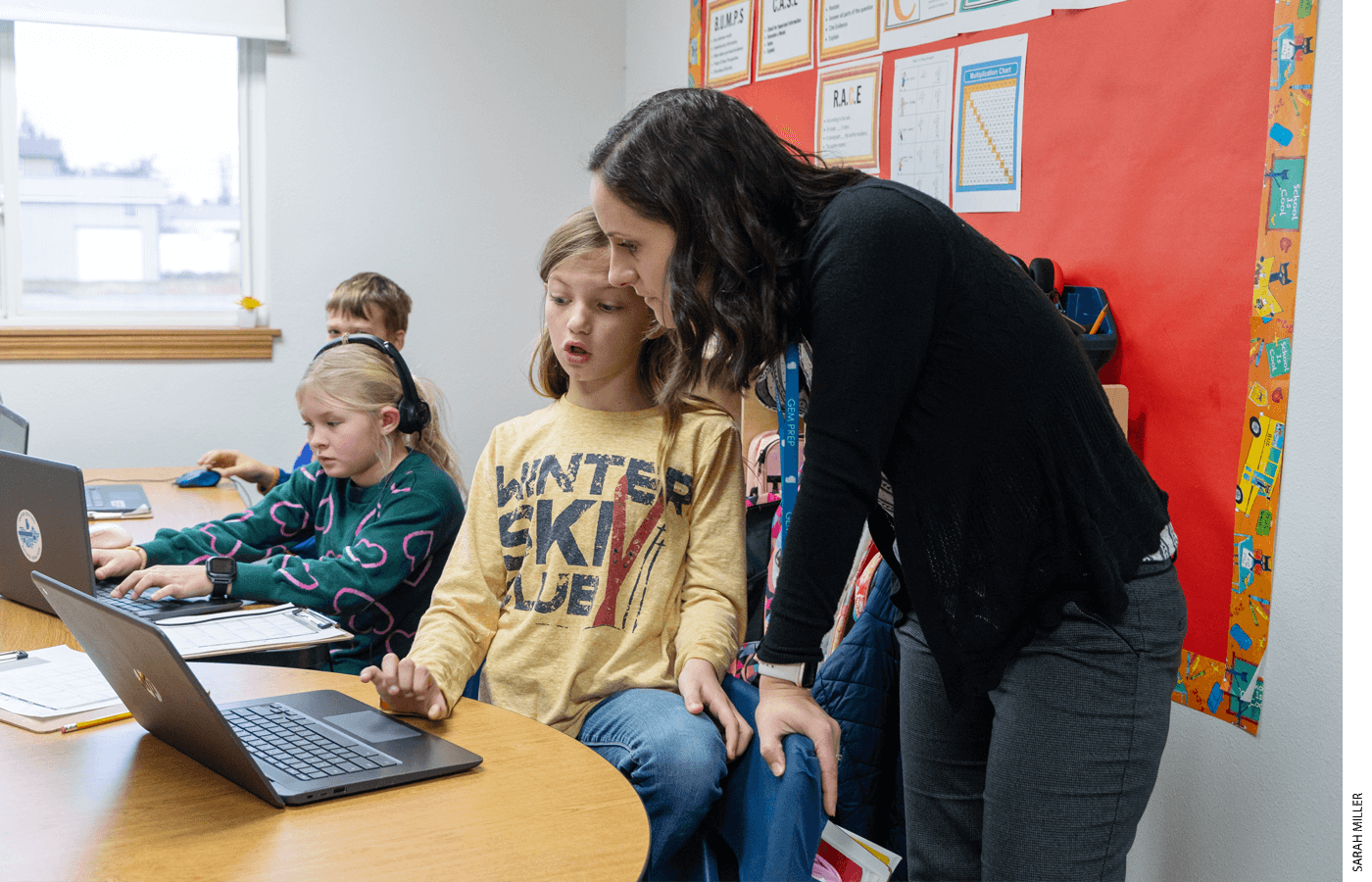
In the ever-shifting world of school choice, what began as a homegrown charter-school network’s small experiment in microschooling stands out as unique—and as a uniquely promising model for replication.
Gem Prep, a network of seven brick-and-mortar K–12 charter schools in Idaho, anchored by a longstanding and high-performing online school, launched an experiment called Learning Societies at the start of the 2022–23 school year. Two publicly funded Learning Societies opened in August 2022, one in the hamlet of Emmett, 30 miles northwest of Boise, with 22 students in grades 1–5, and the other in Lewiston in northern Idaho, with seven students in grades 1–5.
The basic idea is this: Some parents who, for a variety of reasons, hesitate to send their children to a traditional brick-and-mortar school have neither the time, inclination, or temperament to homeschool or to monitor a full-time online program. Learning Societies provide an intimate environment where kids, supervised by professional educators, learn online and in small, in-person groups for six hours a day. Gem Prep leaders describe it as a sweet spot between traditional schooling and at-home online learning. It is particularly well suited to rural areas.
While the inaugural year in both Learning Society locations was filled with challenges, those challenges produced valuable lessons that Gem Prep leaders are confident will strengthen the program going forward, as it expands to new locations and more grade levels.
I spent the Learning Societies’ inaugural year tracking their progress for Bluum, a Boise-based nonprofit that acts as a funding intermediary and local champion of entrepreneurial education ventures. I visited each center twice, once early in the school year and once toward the end, and checked in frequently with teachers, parents, and Gem Prep administrators.
It’s a testament to the underlying strength of the academic program that, even as the Learning Societies struggled with operational and procedural snafus, especially in the first few months, parents stuck with the initiative, with very little attrition.
Though online schools in general have been justifiably criticized for poor academic results, Gem Prep Online stands out as an exception. Thirty-five percent of its students are eligible for free or reduced-price lunch, more than in the state as a whole (27 percent). Yet Gem Prep Online, with a homegrown curriculum refined over more than a decade, regularly outperforms state averages in student achievement. In fact, in 2021–22, the online school boasted the state’s highest performance on the Idaho Reading Indicator, which is administered to students in grades K–3.
Most Learning Society students came either from schools in a low-performing rural district (Emmett) or had been homeschooling. In both Emmett and Lewiston, most students entering the program had been working significantly below grade level, with only 18 percent of incoming students scoring at the proficient level on the fall state-mandated reading assessments.
Learning Societies have the potential to achieve a happy medium that combines the strengths of both homeschooling (or online learning from home) and a traditional brick-and-mortar school. The idea for the program developed among Gem Prep staff and leadership during the Covid-19 pandemic, when everyone was forced for a time into remote learning.
For some families, where parents had no choice but to leave home for work, this posed an almost insurmountable problem. Their children were home, learning remotely, but the younger ones needed adult supervision to navigate online systems.
In some places across the country, including Idaho, families formed informal “pandemic pods”—essentially parent-run learning cooperatives. But, Gem Prep leaders wondered, what if a school staffed by professional educators could provide a similar service across the state, even after the pandemic ended?
Thus were Learning Societies born.
“By several measures, Gem Prep Online is a top school in the state,” said Jason Bransford, Gem Prep’s CEO. “The ability to access that for families who don’t have a full-time adult in the home I think is really a powerful and compelling part of the Learning Societies story.”

The Origins
What would later become Gem Prep Online launched as a statewide virtual charter school in 2004 as the Idaho Distance Education Academy. Gem Innovation Schools, as the organization is officially known, opened its first brick-and-mortar school in 2014 in the city of Pocatello.
Today, Gem Prep operates Gem Prep Online as well as six physical schools in Pocatello, Meridian, Meridian North, Meridian South, Twin Falls, and Nampa. All of them currently or will soon serve students in grades K–12. A campus is scheduled to open in Ammon in 2025. The early success of both Gem Prep Online and the first brick-and-mortar school attracted major investments from Bluum, the J. A. and Kathryn Albertson Family Foundation, and the U.S. Department of Education’s Office of the Charter School Programs. At full enrollment, the Gem Prep Network of Schools will serve 4,600 students statewide.
Gem Prep schools are known for their academic rigor, their high performance, and their philosophy of earned student autonomy. As students progress through the grade levels, they are encouraged to take increased ownership of their learning.
By the time they are in the final two years of high school, many Gem Prep brick-and-mortar students rarely appear on campus. Often, they work independently online, and some attend in-person college classes. Many students take advantage of their scheduling flexibility to participate in internships, jobs, or other activities.
When the Covid-19 pandemic struck, Gem Prep Online’s enrollment swelled by 40 percent, as parents sought options that would keep their students learning at grade level, or at least from not falling too far behind. The pandemic-era shift to online learning gave public-school parents across Idaho an opportunity to see inside their children’s classrooms for the first time. A significant number did not like what they saw. Either they felt the pace of learning was too slow, or that the values being espoused by educators did not align with those of their families, or some combination of the two.
In some communities, groups of parents began forming their own learning co-ops, and some reached out to Gem Prep to see if the charter network, with its long track record of rigorous online learning, might help.
This led Bransford and his team to hatch the idea of Learning Societies. “We realized that we had large Gem Prep schools in some of the biggest cities in Idaho, and then we had Gem Prep Online that you could do from your home. But we didn’t have anything in the middle, and we decided Learning Societies filled a need in society,” he said.
Gem Prep Online only works for families who have a supervising adult at home. Learning Societies, as originally conceived, would provide that supervision for families where parents had to work outside the home.
For the concept to succeed, Gem Prep would have to ensure that these microschools, offering a mix of online and in-person instruction, hewed to the same rigorous education provided at both Gem Prep Online and the network’s brick-and-mortar schools.
Homeschoolers were a group that was likely to be attracted to Learning Societies, especially because many such families might value the assistance of education professionals who could help their children learn without pushing values that are antithetical to the family’s own.
While this proved true from the outset, there was also some potential misalignment, which Bransford and his team moved early to correct.
“Former homeschoolers saw this early on as halfway between traditional schooling and homeschooling, and I don’t see it that way,” Bransford said. “They wanted maximum flexibility, but many of their students had severe academic gaps. And that’s not how we operate. We believe in excellence, then flexibility.”
Gem Prep adheres to the same philosophy of earned autonomy as its brick-and-mortar counterparts. As students move through the grades and demonstrate their ability to take ownership of their learning, they are granted more freedom to direct it themselves, using the Gem Prep Online curriculum.
While Learning Societies welcome all students whose families chose to enroll them, the program particularly suits students motivated to become self-directed learners, said Adam Bruno, a Gem Prep administrator who manages the program.
“Our scholars need to have the innate drive to complete their assignments in a high-quality manner or at least the desire to develop this skill,” Bruno said. “One of our early lessons is that those ‘running from something’—they only chose Gem because they didn’t like the local district—struggled more than those ‘running to’ our model of rigorous self-directed learning. The model can work for any scholar, but there has to be total family buy-in to become a self-directed learner and achieve college readiness.”
Beginning with the 2023–24 academic year, Learning Societies have expanded into the upper grades, where the earned-autonomy concept should increasingly come into play. This should relieve some of the pressure on Learning Society leaders and staff, who have found simultaneously supporting and overseeing the daily work of students in multiple grade levels to be one of the program’s biggest challenges.

Learning Societies in the Microschooling Ecosystem
What makes Gem Prep’s Learning Societies unique is that the microschooling movement largely consists of private enterprises with varying levels of formal structure, which means, among other things, that parents must pay tuition. “The public sector is rarely involved in microschooling, so it is fascinating to see the government sector respond,” said Don Soifer, co-founder and CEO of the Las Vegas–based National Microschooling Center.
Soifer described the Learning Society model as “a novelty in this space.” As microschools have evolved, they have generally fallen into three categories, none of which fits what Gem Prep is attempting. The first category comprises independent schools that Soifer described as similar to pandemic pods. Parents intend to keep them small—the average size is about a dozen students—and have no desire to scale them up.
The second category, which is rarer, consists of “partnership” microschools, generally organized by an employer. Soifer cited a series of microschools he helped run for the city of North Las Vegas during the pandemic. The initiative was funded entirely by city dollars, and the schools were set up in recreation centers, libraries, and other city-owned facilities. To qualify, families had to withdraw from the local school district and become homeschoolers.
The third category is what Soifer calls provider networks. These are companies established to open microschools in school-choice-friendly states that have authorized Education Savings Accounts or other voucher-like programs. He cited Acton Academy, Prenda, and KaiPod as leading examples of microschooling provider networks.
“The provider will do everything you need to get up and running using their model,” Soifer explained. “It becomes easier for somebody who doesn’t want to wrestle with the regulatory stuff, and the business stuff, and the licensing, and designing the teaching and learning.”
Soifer said Great Hearts Academies, a charter network that operates classical academies in Arizona, Florida, Louisiana, and Texas, has moved into the online space and could soon consider a model similar to Learning Societies. For the moment though, Gem Prep’s Learning Societies stand alone.

Lessons Learned in Year One
Gem Prep’s experiment therefore merits close scrutiny. Several key lessons have emerged from the Learning Societies’ first year in Emmett and Lewiston. These ideas should prove useful going forward, particularly with two initiatives launched in 2023–24, a new Learning Society in Payette and the expansion of grades in Lewiston and Emmett through high school.
Communicate clearly to families from the outset exactly what a Learning Society is and how it operates. Families interviewed for this article in Emmett and Lewiston throughout the 2022–23 school year were universally happy with the academic progress their students made. “They were just so far behind, and they have made so much progress. It’s amazing,” said one Emmett mother, who moved her children to the Learning Society from a local public school. “I want to cry when I see how far they’ve come.”
Not all families, however, started with a clear understanding of how the program was intended to function. For example, some parents didn’t realize that the Learning Societies were primarily an extension of Gem Prep Online, rather than a small school with mostly in-person instruction.
Others initially thought of the Learning Society as a kind of drop-in center to be used at their convenience rather than a structured day that required regular attendance. Bransford said Gem Prep will be clearer about the network’s philosophy going forward.
“If a student is performing really well, we want to provide maximum flexibility and freedom. But if the student is struggling, we double down and provide more interventions and support,” he said.
Hire experienced educators who feel comfortable with significant autonomy. Initially, Gem Prep leadership envisaged staffing Learning Societies with a leader who had at least the equivalent experience working with children as a public-school paraprofessional, along with a second adult, most likely a parent, to help out as needed. For the program to work financially, there couldn’t be more than one paid adult for every 20 children. Parent volunteers would have to supplement the paid staff where needed.
Experience proved, though, that a successful Learning Society requires an experienced teacher, not just a paraprofessional. In Lewiston, with an enrollment of seven students in grades 1–5, leader Lois Bly was a veteran Gem Prep teacher. One parent volunteer also had a teaching license and helped out at least one day each week. Bly proved to be the model of a Learning Society leader. Not only did she have both a teaching background and Gem Prep experience, but she also had the temperament to navigate the rocky road of a start-up.
Such was not the case in Emmett, where the leader for the first few months was a parent who, before taking on the role shortly before school started for the year, had been a stay-at-home mom for 15 years. Because Emmett had more students than Lewiston, she had a full-time assistant, a young man with very limited teaching experience. By October the leader had stepped into a part-time role, and by the holiday break she had resigned and withdrawn her children from the Learning Society.
Her replacement, a young woman with a modest amount of teaching experience in public schools in another state, lasted through the school year, but she became disenchanted after just a few weeks and notified Gem Prep she would not be returning for the following school year. She felt that the systems and structures in place were insufficient for the task at hand and that students were being short-changed as a result.
In many ways, the program in Emmett was held together by the close-knit parent community, who, despite the Society’s leadership issues, saw their children making strong academic progress.
While some of the challenges in Emmett were caused by insufficient preparation on Gem Prep’s part, the bigger issue was expecting too much from the people initially hired to do the job, educators who lacked the experience and attributes required to succeed as a Learning Society leader.
Gem Prep’s Adam Bruno described what he has learned about the kind of person who can flourish as a leader. In addition to classroom experience, he said, the individual needs “adaptability, flexibility, and chillness; that ability to go with the flow, step in where they’re needed, take coaching, and generally be able to roll with things, because there’s just so many things that come at you out there that you maybe can’t anticipate.”
Equally important, he said, “if it’s somebody who knows Gem Prep, that is really helpful.”
In 2023–24, all three Learning Societies are being led by experienced Gem Prep teachers who also, Bruno believes, have the attributes needed for success.
Ensure that there are enough supervising adults that students don’t fall through the cracks. If parents had one consistent concern throughout the first year, especially in Lewiston, it was that the adult workload in the Learning Societies was overwhelming, bordering on impossible, for the number of paid staffers. A particular challenge for staff was having to fill multiple roles simultaneously: instructor, facilitator, tech trouble-shooter, and coordinator between online teachers and students.
Equally if not more vexing was having to help students across many different grade levels. The youngest students needed constant handholding to use the technology properly and stay focused, which parents believed sometimes left the older students without adequate support.
The need for sufficient staff will undoubtedly pose one of the biggest challenges in creating successful Learning Societies going forward. Because Gem Prep now recognizes that the program requires experienced professional teachers, personnel expenses will be higher than originally anticipated. Those increased costs will make it tough to decrease the student-to-adult ratio below the current 20 to 1. But, Bransford said, an experienced, confident Gem Prep teacher can handle high ratios—assuming the program is dialed in and that leaders are well trained for the role.
Be quick to adapt as circumstances warrant (for example, by extending the school day). When the two Learning Societies launched, they operated with a five-hour day, from 8 a.m. to 1 p.m. Parents felt that this was insufficient and left students with a burdensome amount of work to complete at home. Gem Prep listened to the feedback and offered a “highly encouraged but optional” sixth hour, from 1 to 2 p.m., at the start of the second semester. Virtually everyone took advantage of that opportunity.
This kind of flexibility was a hallmark of Gem Prep’s approach during the inaugural year of Learning Societies, and that trait will serve the program well as it moves forward. Expansion and growth will bring new, unanticipated challenges, and the program’s ability to pivot and adapt will be critical to its continued success.
Find the right mix of online learning, live work with the leader, and independent study. As the year progressed Gem Prep made several changes to how Learning Societies used their time. Initially, the bulk of a student’s day was spent either in live remote lessons with a Gem Prep Online teacher, or working independently on their computers. Little time was spent in small groups working with an adult in the room.
“A parent called it an Internet café, and that was a fair description,” Bruno said.
Parents, educators, and students all found this frustrating at the outset. “Our kids need that in-person time, and that’s something our teachers just don’t have time to do,” one mother said in October. But by November, she said she was seeing more of an effort by staff to pull out small groups and work with them on lessons.
Bruno said that as currently conceived, elementary students will spend about 45 minutes of the day in a live, online lesson with a teacher. Up to 90 minutes will be spent working in the classroom with the leader or an aide. The rest of the day will be spent working independently or in small groups on lessons or projects, with time also built in for meals and recess.
“What I probably didn’t frame as well as I could at the outset, even for myself, was how do we keep the best parts of Gem Prep Online and bring it into a hybrid concept?” Bruno said. “And then, on the other hand, how do we bring the best parts of our brick-and-mortar schools into that mix? When we get that locked in, we will be really strong.”
Student Progress
Parents I interviewed were satisfied with the progress their children made in 2022–23. Students entered the Learning Societies with significant deficiencies in reading ability. By spring, 58 percent of students were reading at a proficient level, up from 18 percent the previous fall. In just the first year, these students had shown strong academic growth across all demographics.
Across the two campuses, on the normed ISIP reading assessment, part of the Istation online reading program, nearly half (48 percent) of all Learning Society students scored at least 20 percentage points higher in May than they did on their initial test in September. And 43 percent of students exhibited similar growth on the math assessment over the same time span.
By the end of the school year, 84 percent of 3rd through 5th graders were proficient in English language arts as measured by the state’s standardized test, and 66 percent were proficient in math. Those levels are significantly above statewide averages.
It’s not surprising, then, that two of the three Learning Societies operating in 2023–24—Emmett and Payette—began the year with close to full enrollment of 40 students at each site, while Lewiston has doubled its enrollment from the first year and is just under its capacity of 20 students.
Looking to the Future
Gem Prep administrators have entered the second year of Learning Societies confident that they have hit on a potentially transformative concept. They are eager to expand the program to other parts of the state at a deliberate, cautious pace. Ideally, they would like to add one to two new Learning Societies each year in areas of the state that lack access to a brick-and-mortar Gem Prep School or to other choices.
A few factors will determine whether this growth is feasible. First, there needs to be a critical mass of parents committed to placing their children in a Learning Society, which is a new and unfamiliar structure for most people.
Second, Gem Prep has to locate affordable space to rent or buy that fits the needs of a small school and meets the required building and safety codes. Inadequacies in the Emmett space in 2022–23 caused some challenges that continued throughout the year.
Third, every Learning Society needs a leader who has the attributes described earlier in this article. Ideally, a leader should be an experienced educator who either has worked in the Gem Prep ecosystem or is familiar with the network and its operating principles and philosophies.
“We’re really excited about the future of Learning Societies and what they can provide for Idaho families,” CEO Jason Bransford said. “We’ve learned a lot, and we still have a lot to learn, but the potential is clear.”
Alan Gottlieb is a Denver-based education writer and co-founder of Chalkbeat.
This article appeared in the Spring 2024 issue of Education Next. Suggested citation format:
Gottlieb, A. (2024). The Rise of Learning Societies: A small experiment in rural Idaho holds big promise for student success. Education Next, 24(2), 14-21.


